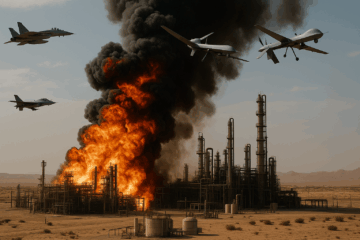As the November presidential election approaches, the prospect of a second Donald Trump presidency raises important questions about the future of American nuclear deterrence. Trump’s first term was marked by a significant focus on nuclear weapons modernization and a distinct approach to nuclear deterrence that contrasted sharply with his predecessor. Understanding what nuclear deterrence could look like under another Trump administration requires a closer examination of his past statements, policies, and actions, as well as the perspectives of his closest national security advisors.
Trump’s Views on Nuclear Weapons: Modernization and Importance
Throughout his first term, Trump consistently emphasized the importance of nuclear weapons to national security. He viewed nuclear modernization as essential to maintaining military superiority, often stating that the United States must have the strongest nuclear arsenal in the world. In a 2017 interview, Trump said, “We have to be the top of the pack,” signaling his commitment to nuclear dominance.
Trump’s push for nuclear modernization culminated in the 2018 Nuclear Posture Review (NPR), which highlighted the need to revitalize the nuclear triad—comprising land-based intercontinental ballistic missiles (ICBM), submarine-launched ballistic missiles (SLBM), and strategic bombers. The NPR called for developing low-yield nuclear warheads, modernizing aging delivery systems, and investing in new nuclear command, control, and communication (NC3) infrastructure. These initiatives reflected Trump’s belief that a robust and credible nuclear deterrent is the bedrock of national security.
Policies and Actions During Trump’s First Term
Trump’s nuclear policies were characterized by a blend of assertiveness and unpredictability. He withdrew the United States from the Intermediate-Range Nuclear Forces (INF) Treaty, citing Russian violations, and signaled reluctance to renew the New START Treaty without significant changes such as adding China to the treaty. While these actions were criticized by some as undermining arms control efforts, they were consistent with Trump’s view that the United States should not be constrained by treaties that he perceived as one-sided or outdated.
Under Trump, the Pentagon pursued the development of new nuclear capabilities, including the W76-2 low-yield warhead, which was deployed on Ohio-class submarines. This move was intended to provide the US with more flexible and credible deterrence options, particularly against regional adversaries. Trump also supported the development of the Sentinel ICBM to replace the aging Minuteman III.
However, Trump’s approach to nuclear deterrence also included moments of brinkmanship and unpredictability. His “fire and fury” rhetoric toward North Korea and his famous twitter threat that “I too have a nuclear button, but it is a much bigger & more powerful one than his, and my button works!” underscored his willingness to use the threat of nuclear force as a means of coercion.
While these statements alarmed many, they also demonstrated Trump’s belief in the deterrent value of projecting strength and unpredictability. Ultimately, perceptions of Trump’s nuclear rhetoric varied—some saw it as inflammatory, others as necessary to exercise strength and resolve—but the fact remains that during his administration, the US avoided major conflicts.
The Role of Trump’s National Security Advisors
Trump’s national security advisors played a crucial role in shaping his nuclear policy during his administration and are likely to continue to do so moving forward. Looking ahead, a potential Trump administration is already seeing a contest for top national security positions, with figures like Richard Grenell and Elbridge Colby emerging as frontrunners for the role of National Security Advisor. Grenell is known for his staunch “America First” stance and his confrontational style, which aligns closely with Trump’s preferences. Colby, a former senior Pentagon official, is a strong advocate for focusing military efforts on countering China, potentially signaling a shift in priorities away from Europe.
The selection of these advisors would likely shape Trump’s nuclear policy in significant ways, emphasizing a hardline stance on China, a push for further nuclear modernization, and a continuation of the “America First” doctrine that marked his first term. As Trump’s potential return to the White House looms, the advisors he chooses will play a pivotal role in determining how the US navigates the complex landscape of nuclear deterrence and global security.
What Could a Second Trump Term Mean for Nuclear Deterrence?
If Trump were to return to the White House, it is likely that his administration would continue to prioritize nuclear modernization. The Sentinel program, the development of the Columbia-class submarine, and the enhancement of NC3 infrastructure would likely remain top priorities. Additionally, Trump could seek to further expand the nuclear arsenal quantitatively and qualitatively, potentially fielding new nuclear weapons, such as sea-launched cruise missiles (SLCM) or new low-yield options.
A second Trump term could also see a continuation of his assertive approach to arms control. Trump may push for more stringent terms in any potential arms control agreements, or he could further distance the US from existing treaties if he perceives them as constraining American capabilities. This approach could lead to increased tensions with China and Russia, potentially sparking a new arms race, or it could be the exact prescription required for effective arms control.
At the same time, Trump’s willingness to engage in high-stakes diplomacy, exemplified by his dealings with North Korea, indicates he might pursue similar approaches with other nuclear-armed adversaries. However, the unpredictability that defined his first term could heighten the risk of miscalculation or escalation, especially in nuclear crises, or it could be that it just happens to induce a proper amount of fear that the adversary effectively backs down or ceases operations. Ultimately, Trump’s unpredictability serves as a tool to instill fear and uncertainty in adversaries, keeping them cautious and off-balance.
Conclusion
A second Trump presidency could bring renewed momentum to US nuclear deterrence and modernization efforts. Trump’s first term demonstrated a clear commitment to revitalizing America’s nuclear arsenal, recognizing its crucial role in maintaining national security. His administration prioritized the development of modern capabilities, ensuring the nuclear triad remains credible and effective.
Trump’s focus on nuclear superiority aligns with his “America First” doctrine, which emphasizes the importance of military strength in securing peace and stability. By continuing to push for advanced nuclear technologies and modernized infrastructure, a second Trump term could restore America’s position as the world’s foremost nuclear power. A second Trump presidency, therefore, could enhance American nuclear deterrence, ensuring that the arsenal remains a potent force for peace and stability in an increasingly complex global landscape for years to come.
Aaron Holland is a PhD candidate at the University of Utah and is an Analyst at the National Institute for Deterrence Studies. Views expressed in this article are the author’s own.
About the Author

Aaron Holland
Aaron Holland is an Analyst at the National Institute for Deterrence Studies.




